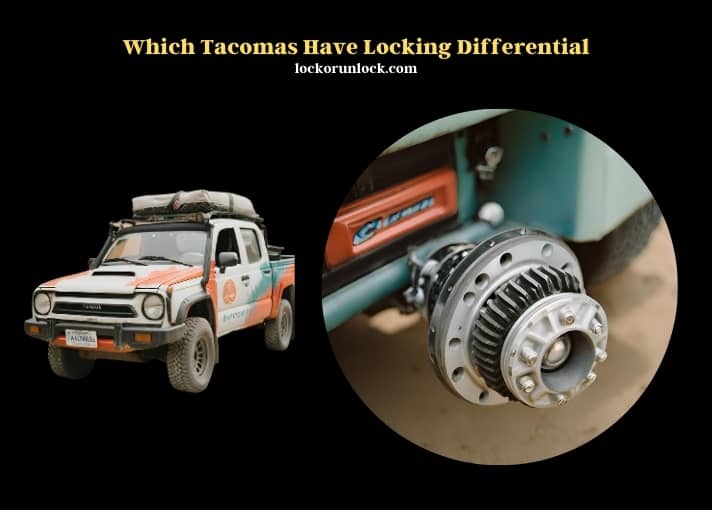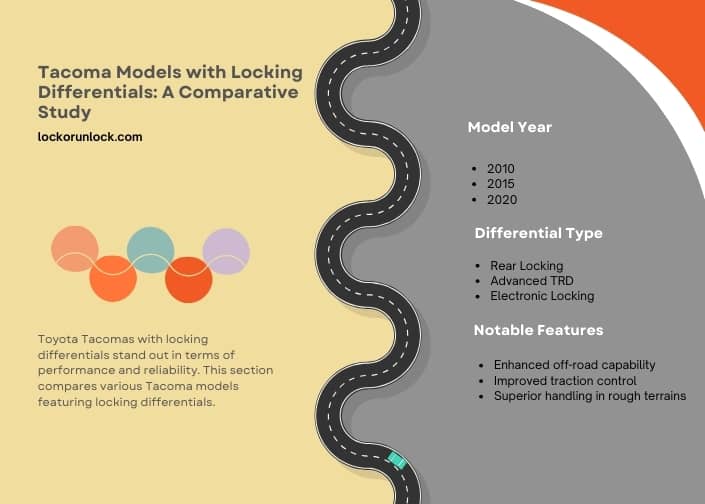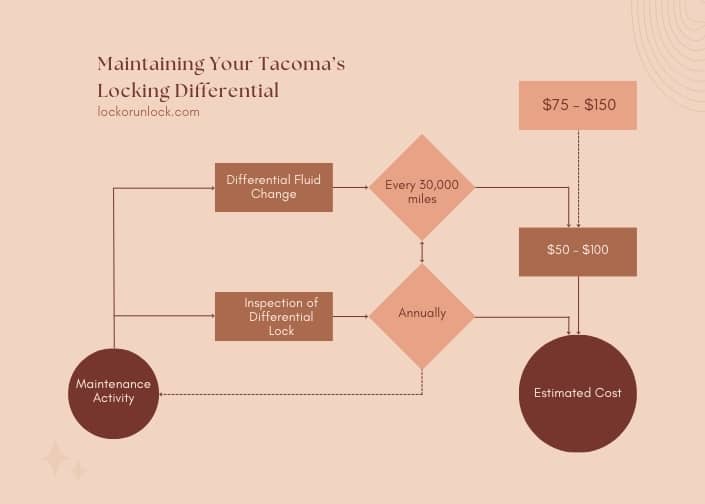Toyota Tacomas equipped with a locking differential are primarily found in the TRD Off-Road and TRD Pro models. This feature is not standard across all Tacoma models but is often included in trims designed for enhanced off-road capability.
The locking differential in select Toyota Tacoma models is a critical feature for off-road enthusiasts. It provides significant advantages in challenging terrains, where maintaining traction is paramount. When engaged, the locking differential ensures that both wheels on the axle turn at the same speed, delivering equal power to each wheel. This mechanism is particularly beneficial in situations where one wheel might lose contact with the ground, such as in rocky or uneven landscapes.

In addition to its off-road benefits, the presence of a locking differential in a Tacoma also speaks to the vehicle’s overall durability and robustness. Toyota’s commitment to producing reliable, off-road capable vehicles is evident in the inclusion of this feature. For those considering a Tacoma for rigorous off-road adventures, opting for a model with a locking differential is a wise choice. It not only enhances the vehicle’s performance in challenging conditions but also adds to the overall value and appeal of the Tacoma as a versatile and capable off-road vehicle.
Locking Differentials in Toyota Tacomas: A Historical Perspective
Locking differentials have been a pivotal feature in Toyota Tacomas, enhancing their off-road prowess. This technology, integral to the Tacoma’s design, has evolved significantly over the years. Initially, locking differentials in Tacomas were seen as a niche feature for off-road enthusiasts.
As demand for versatile vehicles grew, Toyota expanded this feature across various models. The benefits are substantial, particularly in challenging terrains where traction is compromised. These differentials lock the wheels on an axle together, ensuring they turn at the same speed. This mechanism is crucial for maintaining control and stability in off-road conditions, making Tacomas a preferred choice for adventurers.
Tacoma Models with Locking Differentials: A Comparative Study
Toyota Tacomas with locking differentials stand out in terms of performance and reliability. This section compares various Tacoma models featuring locking differentials.
| Model Year | Differential Type | Notable Features |
| 2010 | Rear Locking | Enhanced off-road capability |
| 2015 | Advanced TRD | Improved traction control |
| 2020 | Electronic Locking | Superior handling in rough terrains |

Consumer reviews consistently praise the enhanced off-road performance of these models. The 2015 Tacoma with the Advanced TRD package, for instance, is often highlighted for its superior traction control, making it a favorite among off-road enthusiasts. Year-wise, these models have seen improvements in both technology and performance metrics, catering to a growing market of users who seek adventure and reliability.
Enhancing Off-Road Performance: The Role of Locking Differentials in Tacomas
Locking differentials significantly boost the off-road capabilities of Toyota Tacomas. These differentials play a critical role in navigating challenging terrains by evenly distributing power to the wheels, ensuring better grip and control. In real-world scenarios, such as rocky landscapes or muddy trails, Tacomas equipped with locking differentials exhibit remarkable performance. Experts in off-road driving often cite the enhanced stability and control offered by these systems. Case studies of Tacomas navigating various terrains further attest to the effectiveness of locking differentials in improving off-road performance.
Maintaining Your Tacoma’s Locking Differential
Proper maintenance is key to the longevity of locking differentials in Toyota Tacomas. Regular checks and timely servicing can prevent common issues and ensure optimal performance.
| Maintenance Activity | Recommended Interval | Estimated Cost |
| Differential Fluid Change | Every 30,000 miles | $75 – $150 |
| Inspection of Differential Lock | Annually | $50 – $100 |

Adhering to these maintenance schedules helps in preserving the differential’s functionality and prolongs the vehicle’s life. Experts also recommend seeking professional advice for any signs of wear or unusual noises, as early detection can prevent more significant issues.
Future of Differential Technology in Toyota Tacomas
The future of differential technology in Toyota Tacomas looks promising, with emerging technologies poised to enhance off-road capabilities further. Industry trends indicate a shift towards more sophisticated, electronically controlled systems, offering improved traction and handling. Potential upgrades in future Tacoma models may include advanced sensors and AI-driven control systems, providing an even more intuitive off-road experience. Experts predict these advancements will set new standards in off-road vehicle technology, making Tacomas more capable and versatile than ever.
FAQs
Can All Tacoma Models Be Equipped with a Locking Differential?
Not all Toyota Tacoma models come equipped with a locking differential. This feature is typically reserved for specific trims and packages, particularly those designed with off-road capabilities in mind. For instance, the TRD Off-Road and TRD Pro models often include a locking differential as a standard or optional feature. It’s essential for potential buyers to check the specifications of the model they are interested in, as this feature varies across different years and trims. The inclusion of a locking differential is a critical factor for those who prioritize off-road performance in their vehicle choice.
Is Retrofitting a Locking Differential in a Tacoma Possible?
Retrofitting a locking differential into a Toyota Tacoma that didn’t originally come with one is possible but involves significant modifications. This process requires mechanical expertise and can be costly, depending on the model and year of the Tacoma. It’s crucial to consider the compatibility of aftermarket differential systems with the specific Tacoma model.
Retrofitting might affect the vehicle’s warranty and should be done by a professional to ensure safety and functionality. Owners interested in this upgrade should consult with a trusted mechanic or a Toyota specialist to understand the implications and feasibility.
What’s the Difference Between a Locking and Limited-Slip Differential in Tacomas?
The key difference between a locking differential and a limited-slip differential in Toyota Tacomas lies in their operation. A locking differential can lock the axle’s two wheels together, providing equal power to both, regardless of traction conditions. This is particularly useful in off-road situations where one wheel might lose traction.
On the other hand, a limited-slip differential distributes power to the wheel with the most traction, reducing power to the wheel with less grip. While both improve traction in challenging conditions, a locking differential is generally more effective in extreme off-road scenarios.
How Does a Locking Differential Affect Tacoma’s Fuel Efficiency?
The impact of a locking differential on a Toyota Tacoma’s fuel efficiency is generally minimal during normal driving conditions. When the differential is not engaged, it operates like a standard differential, and there’s no significant effect on fuel consumption.
When the locking mechanism is engaged, particularly in off-road conditions, there may be a slight increase in fuel consumption due to the differential’s operation and the nature of off-road driving, which often requires more power. Overall, the impact on fuel efficiency is not a major concern for most Tacoma owners.
Are There Specific Driving Conditions Where a Tacoma’s Locking Differential Shouldn’t Be Used?
A locking differential in a Toyota Tacoma should not be used in normal driving conditions, especially on dry, hard surfaces. Engaging the locking differential on such surfaces can lead to increased tire wear and strain on the drivetrain. It’s designed for low-traction situations, like mud, snow, or loose gravel, where wheels need equal power to maintain traction.
Using it on regular roads can make handling difficult and potentially damage the vehicle. It’s best to engage the locking differential only when necessary and disengage it once the vehicle is back on stable, high-traction surfaces.
What Maintenance Does a Tacoma’s Locking Differential Require?
Maintaining a locking differential in a Toyota Tacoma involves regular checks and servicing to ensure its longevity and proper functioning. It’s advisable to check the differential fluid levels periodically and replace the fluid according to the manufacturer’s recommendations. This typically involves draining and refilling the differential with the appropriate type of fluid.
Regular inspections for leaks or damage are also important, as these can affect the differential’s performance. Adhering to a maintenance schedule and addressing any issues early can prevent more significant problems and ensure the differential operates effectively, especially under demanding off-road conditions.
Toyota Tacomas with locking differentials represent a blend of innovation, performance, and reliability. From their historical evolution to future technological advancements, these features have played a significant role in defining the Tacoma’s off-road identity. Whether it’s through comparative analysis, understanding their impact on off-road capabilities, or exploring maintenance and future trends, it’s clear that locking differentials are a key component in the enduring appeal of Toyota Tacomas.
